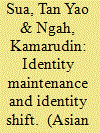| Srl | Item |
| 1 |
ID:
117695


|
|
|
|
|
| Publication |
2013.
|
| Summary/Abstract |
This paper examines the state of identity maintenance and identity shift among the Tirok Chinese Peranakan in Terengganu who are an acculturated rural Chinese community in a Malay populated area. The current older generation still maintains the Peranakan identity, featuring strong Malay cultural influence. Their acculturation by the larger Malay community could be attributed to the combination of three factors: confinement to a Malay environment, common schooling with the local Malays and strong Sino-Malay ties. Malay cultural influence is most evident in their spoken language, building architecture, dressing style, cuisine, eating habits and female inheritance rights. However, amidst acculturation, they still maintain a strong Chinese identity that has been manifested through their observance of Chinese religious and cultural practices, their usage of the Chinese dialect as the home language, their preference for wearing Chinese-style attire in public and their preference for intra-ethnic marriages. But the Peranakan identity has been eroded over the years. There is a noticeable identity shift among the current younger generation as new intervening socio-cultural factors have reduced their interactions with the local Malays and heightened their Chinese identity. The degree of identity shift, however, differs between the current second and third generations and also between those who have moved to town and those who remain in Tirok.
|
|
|
|
|
|
|
|
|
|
|
|
|
|
|
|
| 2 |
ID:
158037


|
|
|
|
|
| Summary/Abstract |
This article addresses the challenges of understanding, measuring and explaining political identities in post-1997 Hong Kong. It shows that national and local identities are better conceptualized as two distinct attitudes and captured with separate scaled items than as opposite poles of one attitude measured in a single categorical item. This approach reveals that the key shift occurred not in local identity, but in nationalistic sentiments, which have initially increased but have been on a downward trend since 2008. It also shows that national and local identities were perceived as robustly compatible for most years since 1997, but have begun to drift apart in recent years. Considering competing accounts to explain national identity strength, trust in the central government stands out as the dominant factor. Discontent with livelihood conditions and socio-structural variables either have no significant effect or are to a large part the result of differences in political trust.
|
|
|
|
|
|
|
|
|
|
|
|
|
|
|
|